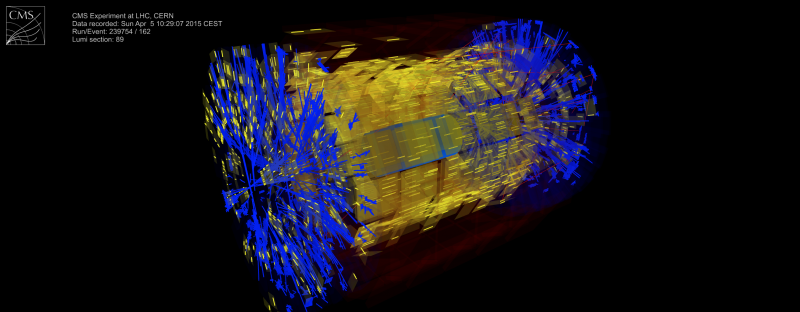Yesterday was an exciting day! While many people were hunting for eggs in their gardens and enjoying a nice Easter-Sunday lunch, physicists and engineers from CMS congregated in their control room near Cessy in France to partake in their own hunt: for the first signs of particles from the LHC in the CMS detector for two and a half years. In the morning the LHC operators started to thread the protons beams around the 27km ring, sector by sector. They first tried with "beam 2", the anti-clockwise beam. Protons were injected into the LHC from the smaller - but still 7 km in circumference - Super Proton Synchrotron (SPS) at an energy of 450 GeV near to "Interaction Region 8" (IR8 - the location of the LHCb experiment) - see diagram below. These protons then started to travel around the LHC, guided by the famous 15m-long dipole magnets, but were deliberately stopped in their tracks by closing "collimators". These collimators were first closed near to IR7, then IR6 and finally just before IR5 - where CMS is located. When the beam hits the collimators a "splash" of particles is produced that can travel through the detector.

At around 10:30am yesterday the first splashes were seen in the CMS detector. In fact they were heard before they were seen: an audio signal - the sound of a wave splashing on rocks - was heard throughout the control room. Eyes then turned to the various monitors around the room, showing traces and plots and pictorial representations of the particles in the detector, such as the one below. This image made its way out of the control room onto news media sites all around the world! Five splash events were initiated by the LHC and observed by CMS.

Although it may seem easy for CMS to be able to see such events, in fact it is a rather unique challenge. The CMS detector is so large that even particles traveling close to the speed of light (as these particles are) leave their signals in different parts of the detector at different times. Indeed the detectors at one end of CMS see the particles about 70ns (70 billionths of a second) earlier than the other end. So we need to look for the passage of particles at different times in different detectors - and this also depends on the direction of the beam! But, as seen from the image above, we managed to do this and could use the knowledge of the location of the various detectors of CMS to understand if we had indeed timed-in the different parts correctly. This analysis is now ongoing by physicists all around the world.
But sometimes unexpected problems arise, just at the wrong time. About fifteen minutes before the LHC attempted to thread beams around the opposite direction, one of the CMS subsystems experienced a glitch that resulted in it turning off that system as a precautionary measure, to prevent any possible damage to that detector. An examination was quickly performed, determining that it was just a very rare communication glitch, there was no real danger, and it could be safely turned back on again. This process is not just "flicking a switch" and takes a little time. And by the time everything was again stable, the LHC was no longer "knocking" at the CMS "door" to see those splashes. It's better to be safe than sorry and, of course, there is always tomorrow - quite literally in this case: the next stage in the LHC commissioning plan is to provide a large number of splashes - in both directions - between this evening and early morning on Tuesday. So a long night is ahead of us tonight, but certainly an exciting one, that is a milestone for the commissioning of CMS to be ready to detect whatever the LHC creates in particle collisions in the coming years! And, of course, the milestone reached yesterday was already cause for celebration!

The views expressed in CMS blogs are personal views of the author and do not necessarily represent official views of the CMS collaboration.
